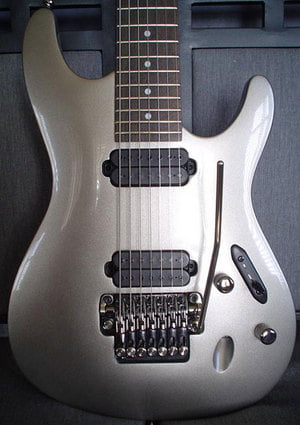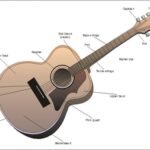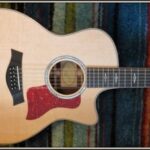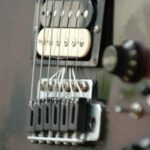The biggest complaint I hear from guitar players is that most guitars available in their price range do not come in a very wide variety of colors. They mostly come in black. Yawn. With a little elbow grease and a little patience, you can paint your own and get a factory finish for a fraction of the cost. Let’s face it… most guitarist that I know just cannot afford to pay a professional to re-finish their guitar.
The first thing you have to deal with is removing the existing finish on the guitar. For that, I recommend getting an electric, random orbit sander and some varying grits of sanding discs to go with it. I’d say 100 grit to 220 or 320 grit. You may also want to get some regular sand paper in those grits for some hand sanding in certain areas that the random orbit sander can’t reach. Stay away from any electric “block” sanders. They take forever and are more damaging to your wrists due to the intense vibrations they put off.
You may also want to try using a heat gun and a metal putty scraper to start off with. Chemical paint strippers can work too but they give off horrid fumes. With some practice, you can strip an entire guitar body with a random orbit sander and some hand sanding in about 1 hour. Also, when stripping a guitar body, you will get down to what looks like a thick, waxy, clear coat. Try to leave that on. It is called the “sanding sealer.” It’s there to fill up the wood grain and any sanding scratches. If you go through it, you can buy some at your local hardware store for a few bucks and re-apply it.
Next is choosing your paint. The brand of paint doesn’t really matter here. What matters is the type. I like to use, and recommend, acrylic lacquer for your primer, base(color coat) and clear. Whatever you use, make sure they are all the same type. Stay away from any enamel paints. I tend to use Duplicolor paints that can be found at most auto parts stores. For the number of coats, I usually do about 2-3 coats of primer to get things smooth. 2-3 coats of the base or “color coat.” Then I apply anywhere from 10 to 25 coats of clear.
It seems like a lot but they are fairly thin coats that build up quite nicely. One of the biggest misconceptions is that you have to sand between coats. Not true. The only time I sand between coats is after I put the primer coat on. I maybe go over it lightly by hand with some 320 grit sand paper. And, of course, before you start putting on more paint, make sure that the dust is wiped off. I usually by a couple cans of compressed air(that can be found at an electronics store) to blow the dust off and then wipe it down with a lint free cloth.
Just follow the instructions on the spray paint can and you should be good to go! And be sure you are in a well ventilated area! You can even do it outdoors. Don’t worry, any dust that gets trapped will end up getting sanded out when you do the wet sanding later on.
Now, how do you get that silky smooth, mirror like shine? Simple. Wet sanding and hand buffing! Many people think that in order to get that “shine”, you need to lay the coats on thick. Wrong. That will just increase your chances of getting runs in the paint and it will also trap air in the coats that will later work there way out and leave bubbles in the finish. Here, you will also notice that your finish is all “bumpy” and ugly. That is what’s called “orange peel.” It’s perfectly normal. The wet sanding and buffing will get rid of that.
After letting the clear coat sit for a couple of weeks(Yeah, I know. It seems like a long time and you want to put it back together and play!) you will need some wet sanding paper(800 grit, 1000 grit, 1200 or 1500 grit and 2000 grit) and a spray bottle filled with water. I also add a tiny bit of dishwashing soap to the water. Cut the wet sanding paper into probably 2-3 inch wide strips, fold it into thirds and gradually start sanding your freshly painted guitar body stating with the 800 grit and working your way to the 2000 grit wet sanding paper. You will use the spray bottle to spray the water on before you start wet sanding.
I usually do all the wet sanding in fourths. Spray about 1/4 of the top with a couple of shots from the spray bottle, sand, wipe with a towl and repeat. At first you will notice the finish start to dull and the orange peel will start to dissappear. Don’t worry. You are fine. After you get to the 2000 grit, you will start to notice some shine coming through. Just take your time. Be patient. This part probably takes the longest.
For the buffing, you will need some sort of rubbing compound and clean cloth. For the rubbing compound, I use 3M’s Perfect It II Rubbing Compound. For a cloth, I just use a clean terry cloth bath towel. Drop about a quarter sized drop of the rubbing compound on the guitar body, take the towel and start rubbing it in a circular motion.
After a haze developes, find a clean spot on the towl and do the same until the haze is gone. I do about a 5 inch square area at a time. It will take a while to get the sanding scratches out but once you are done, it will be well worth it. It usually takes me a good afternoon to get the wet sanding and buffing done. So find your self a nice spot on the couch, put in a good movie(or two) and go to work!
When that is all done, just clean your guitar with your usual guitar polish of choice, re-assemble and go play!
Also, keep in mind that your first attempt may not turn out perfect. Even if it takes you a few tries, it’ll still be a lot less costly than if you had it done by a pro. When all was said and done, my first attempt cost me about $100. That included buying the randam orbit sander!








